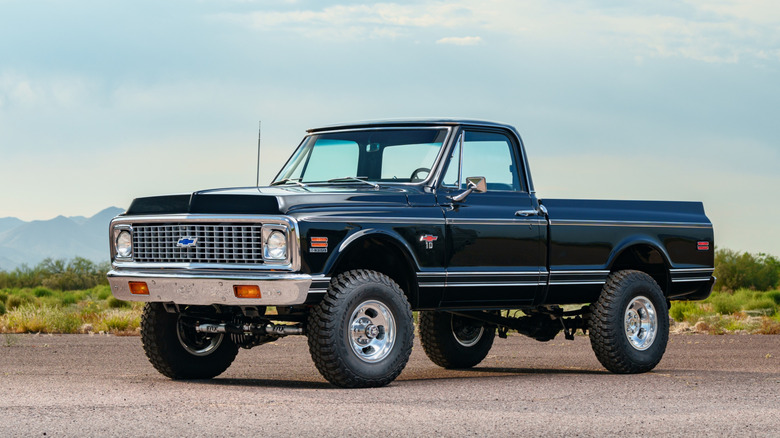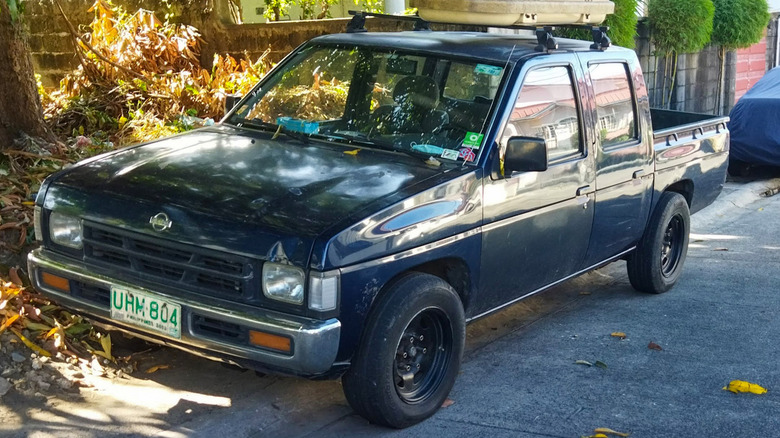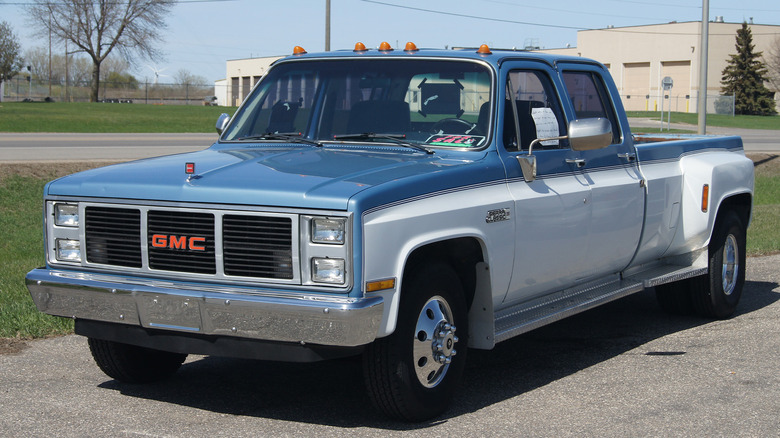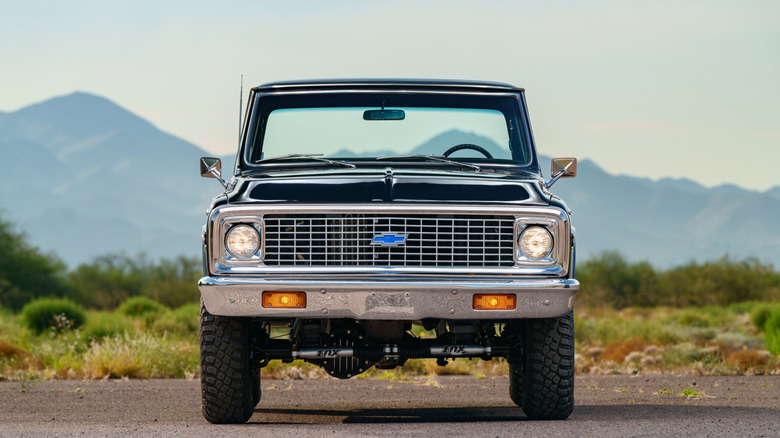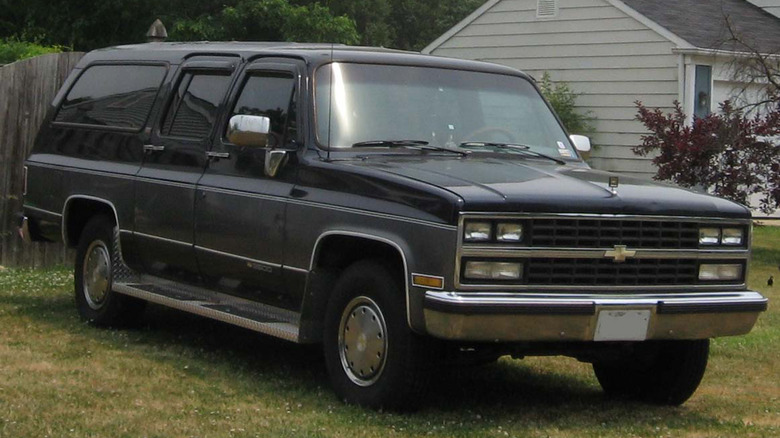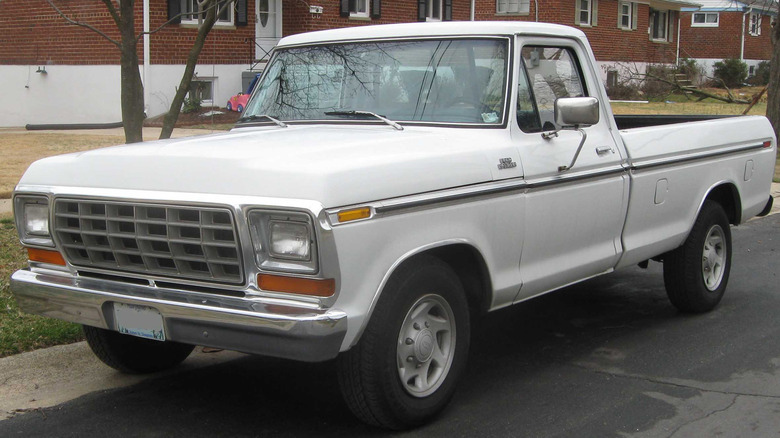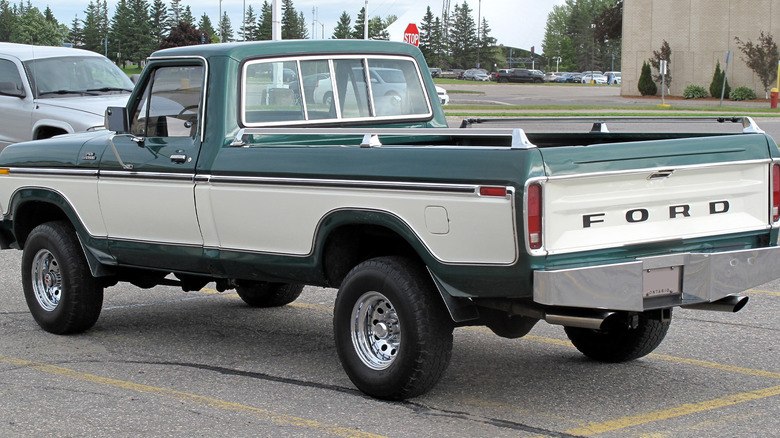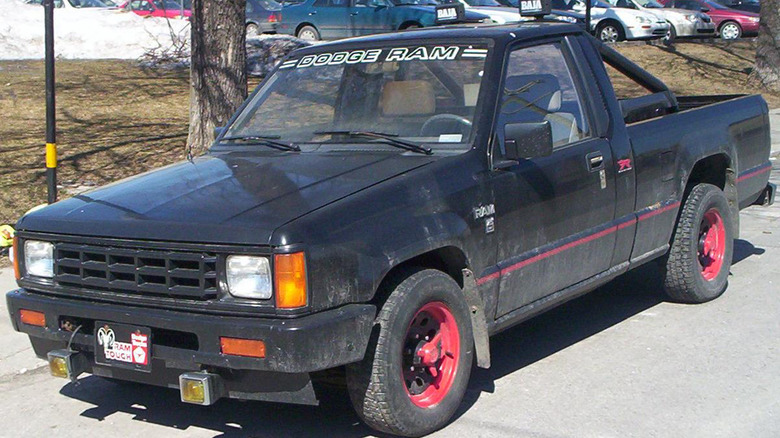9 Of The Most Reliable Square Body Trucks Of All Time
The square body truck was a microcosm within the greater history of the lovable pickup truck. It was essentially an era where Chevy — and later other auto brands — made trucks that had a square body. We know, it's a totally shocking revelation. In any case, the square body truck became best known as the K10 and C10 trucks that GM was making via Chevy and GMC from 1973 to 1987. In the years since, other automakers like Ford, Dodge, and even Nissan had a square body truck design as well.
These trucks were largely known for their boxy shapes and decent reliability. In fact, some people even buy them as collectors' items or buy them, fix them up, and use them like they were intended. The end of the square body era is also a little bit loose. Chevy and GMC came out with rounded-off and more aerodynamic designs in the late 1980s, but the square body design remained alive on the Suburban and Blazer for a few more years. Counting Nissan, the square body fad officially ended in 1987, but extended into the late 1990s.
So, if you're in the market for a square body truck and want a good place to start, below is a list of the most reliable square body trucks we could find. There wasn't much in terms of reliability metrics in the 1970s and 80s, but we did the best we could with the data we could find.
1986-91 Nissan D21 Hardbody
Okay, let's start with a layup and introduce you to the Nissan D21. This is arguably the loosest usage of the term "square body," but Nissan D21 enthusiasts proclaim it as such, and so for the purposes of this list, we will as well. Nissan made the truck from 1986 through the 1997 model year, which means it technically existed after the square body fad was on its way out the door. Don't let that fool you, though; these little things earned a reputation for their reliability and a tolerance for abuse that few other trucks have.
The Nissan D21 is often referred to as the "Hardbody" thanks to its double-walled bed, durable paneling, and design. The term caught on so rapidly that Nissan started referring to the truck the same way in advertising, and as such, people may know the truck more as the Hardbody over its actual name, the D21. The truck came with two engine options, either four-cylinder or V6. The 2.4-liter four-cylinder that output 106 horsepower was eventually replaced with a similarly sized engine that output 134 horsepower. Over the entire course of the model's production, the V6 option output 140 and later 154 horsepower.
In terms of reliability, the Hardbody was known to be quite reliable as long as you kept up with maintenance. For the most part, the engine and truck lasted for a long time, and it was usually the parts around the engine that would go bad. Fortunately, repair and maintenance aren't terribly difficult, so you can keep the truck going for many, many years.
1973-87 Chevy K10 or GM C10 with the Mark IV V8
Many folks will be familiar with the Chevy and GMC square bodies, made by GM from 1973 to 1987. Much like today's trucks, GM included many engine options with the K-series and C-series trucks, including a handful of six and eight-cylinder engines. The square bodies are already considered fairly reliable, despite some model years being 50 years old at this point. If you want the most reliable, one engine option that we'd recommend is Chevy's legendary 454 Mark IV big block V8.
Chevy stuffed the engine into plenty of vehicles, including their other truck models, but it seems most opinions are that the 454 was best served in the square body trucks of the time. Chevy upgraded it multiple times over the years, but ultimately sold the engine in these trucks for their entire run. They were designed for towing and lifting heavier loads, making them excellent for work trucks.
GM worked around emissions standards of the time by installing the engine on rear-wheel drive models that were three-quarter or one-ton rated, allowing the engine to retain horsepower when most other vehicles were losing it. Overall, the engine earned its legendary status, and since it's designed mostly for work trucks, it tends to shrug off regular driving and lighter work. It's been known to have a few issues, but maintenance and proper care can almost entirely mitigate them.
1973-87 Chevy K10 or GM C10 with the Chevy 350 V8
One of the engines that came with GM's square body trucks was the 5.7-liter 350 V8. The small block V8 was the Yin to the Mark IV's Yang. Chevy made the engine from 1955 through 1996, making the 350 one of Chevy's most epic engines ever. It's powered many vehicles over the years, from the Camaro to the humble Chevy K10, and put up decent horsepower while doing it. It's even toward the top of boat engine lists in terms of popularity.
In any case, it's easily the most reliable engine we were able to find for Chevy and GMC's square body trucks. There are myriad stories online about its incredible longevity, but perhaps the cherry on top is the fact that it powered the highest-mileage Chevy in existence to over 1 million total miles. Admittedly, in that instance it was powering a 1991 C1500 Silverado, which isn't a square body truck and assuredly had some improvements since the '70s and '80s. Even so, a million miles is an impressive feat for a truck engine.
If you want the best odds of your square body truck going the distance, you'll want to find a later model of the engine, as Chevy put up a lot of improvements over the years. For example, the 1986 version of the engine came with an aluminum intake manifold instead of cast iron. In any case, the rest of the truck may need some repairs, but the Chevy 350 will likely be the least of your worries.
1991 Chevy Blazer
Chevy and GMC moved on from square body trucks after 1987. However, the square body truck platform remained until 1991, and was mostly used in GM's SUV lineup. That includes the 1991 Chevy Blazer, which we think deserves placement on this list. Since it was the final year of the square body architecture, this is a good way to get in on it while shaving a few years off the age. It's also very reliable, assuming you can find one that the prior owners kept the rust off.
At the heart of this bad boy was the famed Chevy 350 V8. There are reports online of people reaching 350,000 miles with the Blazer equipped with the V8. There were some common issues like power window motors failing, but those were relatively simple to fix and didn't seem to reduce longevity. By most accounts, as long as you maintain the engine, it'll last you a good, long time; many people refer to the '91 Blazer as virtually bulletproof.
There was another model that came with a 4.3-liter V6, and while we weren't able to find nearly as many success stories, people still seemed to like the V6 variant of the truck as well. From what we saw, the benefit of the V6 is that it doesn't have a lot of issues and it's pretty easy to work on. We were able to find stories of people putting up north of 250,000 miles on the V6.
1991 Chevy Suburban
The 1991 Chevy Suburban makes almost an identical case to the 1991 Chevy Blazer. It ran on the square body platform up through 1991, so this is the final model year where you can get a Chevy or GMC square body truck design. Since it's not quite as iconic as the actual square body trucks of the era, you can also pick them up for way less money compared to a regular truck. Chevy kept it fairly consistent, too, even using the C and K naming schemes as with Chevy and GMC square body trucks: the assigned letter to a Suburban denoted whether it had a two-wheel drive (C) or four-wheel drive (K).
For the most part, these are reliable for the same reason the Blazer was. It had the excellent Chevy 350 engine, one of the best engines ever put in a Chevy truck, which is highly reliable and popular among enthusiasts. You can go with any size, but we recommend the three-quarter-ton trucks. The regular half-ton models came with a reasonably good TH350 transmission, but the three-quarter-ton version had an upgraded TH400. Of the two, the TH400 has been shown to be superior in terms of reliability.
Also, much like the Blazer, the problems are rarely with the mechanical stuff but rather with frame and body rust. If you're in the market for one, we highly recommend checking under the truck to make sure there isn't too much rust, or be prepared to drop some money to get rusty body panels fixed up after purchase.
1973-79 Ford F-150 with the 460ci V8
Ford joined the square body fad in 1973 and kept up the Ford F-150's square body design until 1979. Unlike Chevy, which built its square bodies on a whole new platform, the Ford F-150 was using a mostly recycled design that dated back to the mid-1960s. Even so, the Ford F-150 is the most popular truck of all time, and it was during this generation that Ford pulled ahead for what would be half a century of sales dominance. That makes them every bit as collectible as the GM square body trucks, even if Ford is often not included in the definition by purists.
The Ford F-150 originally came with five total engine options, including three six-cylinder engines and two eight-cylinder engines, and at the top of the mountain was Ford's excellent 460 cubic inch big block V8. Granted, these trucks came out in the 1970s, which was right in the middle of the Clean Air Act, but the engines still made decent power and were among the most reliable of any Ford truck of that era. It wasn't quite as tough as Chevy's 5.7-liter, but we found plenty of stories of people who got a quarter of a million miles out of it without too much drama.
It also happened to be the most powerful engine, so if you want to actually use the truck as a workhorse and tow anything, the F-150 square body with the 460 cubic inch V8 is the version you want to go with.
1973-79 Ford F-150 with the 300ci inline-six
The Ford F-150 from the '73 to '79 era was commonly referred to as the "dentside," since while it kept most of the same design elements of the prior generation, it also had a dent in the sheet metal that stretched the entire length of the truck on both sides. Not only that, but it also came in some really cool colors (if you're a fan of earthy '70s tones).
The 300-cubic-inch straight-six that came in the Ford F-150 from that era was surprisingly good, despite being the smallest engine that Ford offered. In terms of reliability, we believe the inline-six is actually better than the V8. Not only do people rave about this engine online, but it's often cited as being indestructible by enthusiast blogs because it usually outlasts the truck itself. Ford actually made this in a few different configurations, but the inline-six is the one that made it into the trucks.
According to one Reddit user named Fliffs, they were driving with the inline-six when a failure caused it to lose all of its oil. The owner drove it for another 60 miles, fixed the failure, and the engine was still functioning at the time of their post. That's impressive no matter how you swing it.
1992-93 Dodge Ram with the Magnum V8
Dodge's square body truck was its first Ram truck. Dodge released the new badge in 1981, and it featured a similar flat grill, boxy shape, and squared off body. Like other American auto makers, the truck had plenty of options under the hood, but as has been the case for Dodge most of the time, the most exciting options were either diesel or V8 engines.
The original Dodge Ram came with a 5.9-liter V8 that was known as the LA, which would be housed in the Ram for most of its square body run but was eventually replaced with the Magnum V8. The latter is very similar to the LA V8 in terms of reliability, but with multi-port fuel injection and other updates, the Magnum is the superior engine.
The Magnum-equipped models squeaked in at the end of the generation, so they're only available in the 1992 and 93 model years. The engine is available in later Rams, but they weren't square body models after 1993. While we don't think it's the best overall engine that Dodge ever installed into a Ram truck, generally speaking, the Magnum V8 has an excellent reputation for reliability and was arguably the best gas engine stashed in a square body Dodge Ram.
1989-93 Dodge Ram with the 6BT Cummins
When Dodge installed the Cummins 6BT turbodiesel into the Dodge Ram, it started a trend that continues to this day, as all other American truck makers now offer turbodiesel engines. The 6BT is one of Cummins' best engines, and it's honestly one of the greatest American-made diesel engines ever put into a consumer vehicle. Dodge's square body Ram was made from 1981 to 1993. However, it wasn't until 1989 that Dodge started including the Cummins 6BT, so if you're in the market for one of these, you have four model years to choose from.
Cummins makes an excellent diesel engine, and the company's engine was a perfect match for Dodge's trucks. Indeed, it's often referred to as the best diesel engine ever made, a fact that Cummins is super proud of, too. The brand has stories on its own website about 6BT engines going 300,000 miles or longer. Cummins engines have been known to go over a million miles as well, matching Chevy's 5.7-liter V8 as the only square body engines that can boast that feat.
However, we're giving the win to Cummins here, since we were able to find stories of a man traveling 2 million miles in his 1993 Dodge Ram 3500, equipped with the Cummins diesel engine. Apparently, he managed the same feat with another Dodge Ram truck with a Cummins engine. We were able to find more stories from Dodge Ram owners with million-mile Cummins 6BT engines than all of the other engines on the list combined.
